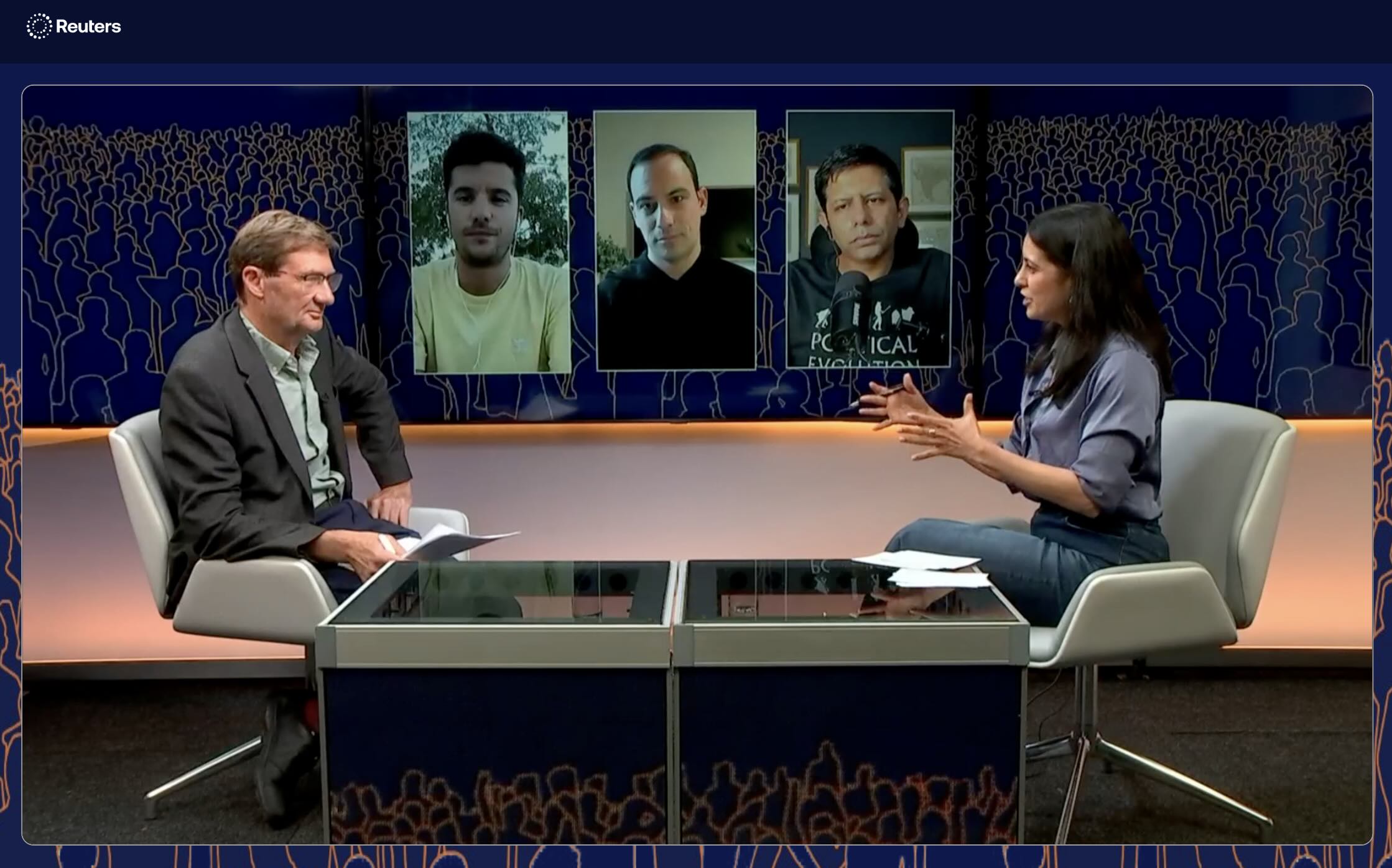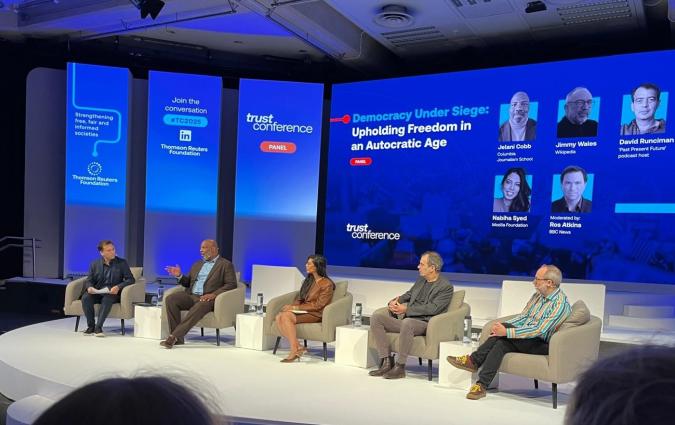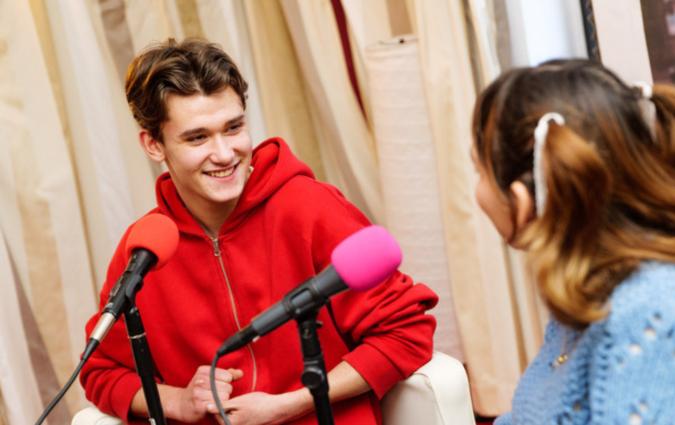‘Building a very different kind of trust’: Four things we learnt at the launch of our report on news creators

The report's lead author Nic Newman, the Institute's Director Mitali Mukherjee, and our three panellists: Emilio Doménech from Watif, Mosheh Oinounou from Mo News, and Akash Banerjee from The Deshbhakt.
What does the news content creator ecosystem look like and what informs their growing prominence in the world of journalism? Three news content creators reflected on this question and many others on the online launch for our new report on the phenomenon.
With over 1,600 registered, the event, hosted by our friends at Thomson Reuters, featured a presentation by lead author Nic Newman and a panel moderated by the Institute's director, Mitali Mukherjee, featuring news influencers Mosheh Oinounou from Mo News in the US, Akash Banerjee from The Deshbhakt in India, and Emilio Doménech from Watif in Spain. Here are some key takeaways from the discussion.
Watch the event
1. Traditional media can (and should) learn from news influencers
Many prominent creators are traditional journalists that started in the content creation space by identifying the gaps in mainstream media. This is the case for both Mosheh Oinounou and Akash Banerjee, who have successfully done what mainstream media has been unable to: attract young audiences. They explained their success in terms of authenticity, relatability, and direct interaction.
“It’s not necessarily comfortable for traditional journalists to share parts of their lives and be open in ways that we are not in traditional media, but that’s one of the appeals and one of the ways to grow on these new platforms,” said Oinounou.
Emilio Doménech started his content creation journey by taking inspiration from gamers on YouTube and Twitch in his native Spain. He said that one of the ways they built trust and connection with their audiences was by having direct interactions with them. Traditional media often lacks this mechanism whereas creators receive immediate feedback and hear what issues their audience wants them to cover.
“When you have a direct connection to your audience because you are interacting with the chat, you can build a trust that feels very different from everything else,” said Doménech.
Another way traditional outlets can learn from creators is by looking at their style of delivering content. Creators generally adopt a more informal and engaging style. Akash Banerjee often mixes news with comedy or satire, speaking the language of his audience and making complex topics easier to digest.
“Rather than me being an all-knowing anchor who is going to tell you everything, I think what appeals to the younger generation is that you are one of us. They trust you,” said Banerjee.
2. Content creators need the mainstream media – but mainstream media also needs them
The creators in the panel acknowledged that they need mainstream media to exist, as they often depend on traditional outlets for background information and news coverage. However, all panellists stressed that the relationship can be a beneficial two-way street, with creators amplifying coverage that could get lost in the headlines.
In Doménech’s native Spain, for example, the main newspapers tend to follow the same news stories every day, regardless of an outlet’s political leaning. “I decided not to follow the same agenda and cover the issues they are not paying attention to,” he said.
These sentiments were echoed by Banerjee, who has partnered with smaller publications, websites and investigative sites which publish solid journalism but lack the necessary reach. With these outlets providing the journalism, the creators can then provide the reach and the ability to communicate with audiences.
“Our work rests on solid ground journalism,” said Banerjee. “Instead of making one big organisation, people can start collaborating with each other. People who do good work can come together for a story and that’s what we do.”
3. Distrust is fuelling the growth of the news creator ecosystem
A major factor driving the audience shift is the lack of trust in legacy news organisations, our panellists said. While this varies across countries and across age groups, younger audiences overall are less likely to engage with traditional media and more likely to pay attention to news creators across different platforms.
Oinounou said that there is not enough transparency in mainstream media, with news organisations being reticent in explaining why they cover what they cover or what they don’t know about the issues.
“In the same way Americans are turning to creators for lifestyle content, for cooking content, for entertainment content, they are also looking for individuals that they trust to bring them news and information at a time when institutional trust continues to collapse here in the US,” he said.
Audiences come to smaller creators because they trust that individual, and that’s why the independence of the creator is hugely important to their audience. Banerjee said that this lack of trust in institutions can lead to an erosion of trust in creators when they become part of these institutions or partner with them.
This was echoed by Oinounou who gave the example of Bari Weiss’ Substack publication The Free Press, recently acquired by Paramount. “[Subscribers] are being like ‘I don't know if I trust it anymore now that they have a billion dollar corporate parent’, so that’s one of the challenges,” he said.
4. Building an audience on platforms is a double-edged sword
According to our own Nic Newman, YouTube is the center of the creator ecosystem in most of the countries covered by our report. However, platforms such as X are really important in some countries, such as the US, Japan, and Nigeria, particularly for political discourse. Younger audiences in many countries are also accessing news content through TikTok and Instagram.
Most creators have implemented a multi-platform strategy. For instance, Mo News, which started on Instagram, has grown by moving into the podcasting and newsletter space and is also flourishing on YouTube. Doménech and his colleagues at Watif started with live events and Substack newsletters, but they have now expanded into streaming.
However, while creators commend adaptation, they caution against trying to blindly conform to algorithms and instead aiming to connect with their audiences. “Things will change. New guys will come in. Space will be created,” said Banerjee. “The brilliance of this fact is that no amount of money, no amount of institutional backing can help you.”
There is also a concern of institutions, or powerful individuals, of capturing platforms. With X and Meta, we have seen how Elon Musk and Mark Zuckerberg can change their platform’s algorithm to their whims.
Governments can also be of concern. In India, where YouTube has been a refuge for prominent journalists leaving mainstream media due to political pressure, things are starting to change. Banerjee said that the government has now started issuing rules for YouTubers, requiring them to register and allowing the government to pull down content without informing creators.
Explore our report on news creators:
- Read the report in full
- Check out the data by country: United States | Canada | Argentina | Brazil | Colombia | Mexico | United Kingdom | France | Netherlands | Norway | Spain | Czech Republic | Poland | Australia | India | Indonesia | Japan | Philippines | South Korea | Thailand | Kenya | Nigeria | South Africa
In every email we send you'll find original reporting, evidence-based insights, online seminars and readings curated from 100s of sources - all in 5 minutes.
- Twice a week
- More than 20,000 people receive it
- Unsubscribe any time






